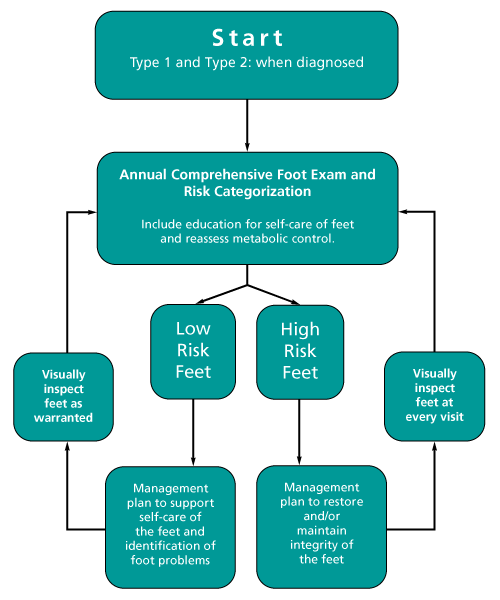|
|
 |
 |
 |
| |
Flow Chart for Diabetes Foot Exams*

* Adapted from Population-Based Guidelines for Diabetes Mellitus. Health Promotion and Chronic Disease
Prevention Program, Oregon Health Division and Oregon Department of Human Resources, 1997.
Diabetes Foot Exam Procedures
| Category of Patient |
Recommended Procedure |
Frequency |
Persons with:
- Type 1 diabetes
- Type 2 diabetes
|
Comprehensive foot exam to identify high risk foot conditions. A physician or other trained health care provider should:
-
Assess skin, hair and nails, musculoskeletal structure, vascular status, and protective sensation.
-
Inspect footwear for blood or other discharge, abnormal wear patterns, foreign objects, proper fit, appropriate material, and foot protection.
-
Educate about self-care of the feet.
-
Educate about the importance of blood glucose monitoring including the use of the Hemoglobin A1c test.
- Reassess metabolic control.
Management plan.
-
The subsequent foot care management plan depends on risk category, foot status, and metabolic control.
-
High risk patients should be referred to a health care provider with training in foot care.
|
Annually or when a new abnormality is noted |
Persons at: |
|
|
|
Visual foot inspection to identify foot problems. A physician or other trained staff should perform the foot inspection. |
At every visit |
|
(Refer to chart for definitions of risk) |
|
As warranted |
|
|
| |
|
|
| |

National Diabetes Education Program (NDEP) http://ndep.nih.gov
NIDDK, National Institutes of Health, Bethesda, MD
A Joint Initiative of the National Institutes of Health and the
Centers for Disease Control and Prevention |
|
| |
|

Includes information about managing the ABCs of Diabetes. Also features information for people with diabetes who are eligible for Medicare benefits.
Learn how to prevent or delay type 2 diabetes through small steps.
|









